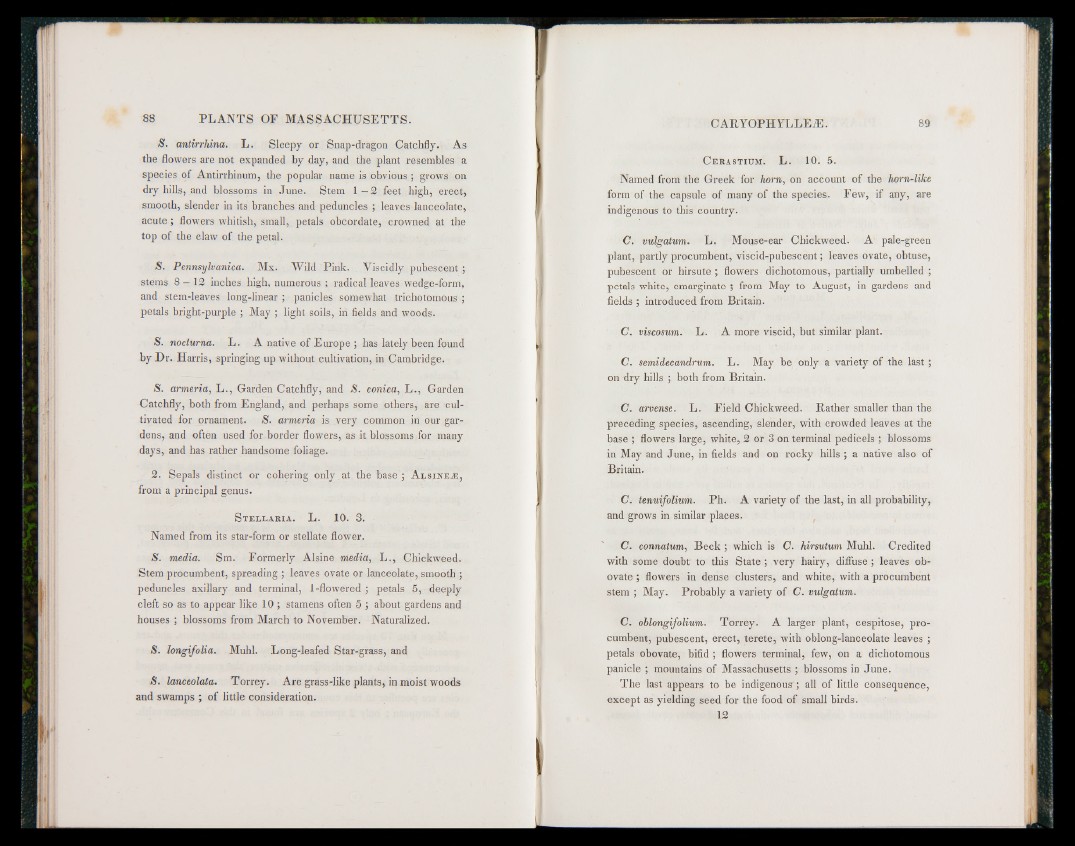
<S. antirrhina. L. Sleepy or Snap-dragon Catchfly. As
the flowers are not expanded by day, and the plant resembles a
species of Antirrhinum, the popular name is obvious ; grows on
dry hills, and blossoms in June. Stem 1—2 feet high, erect,
smooth, slender in its branches and peduncles ; leaves lanceolate,
acute; flowers whitish, small, petals obcordate, crowned at the
top of the claw of the petal.
Pennsylvanica. Mx. Wild Pink. Viscidly pubescent;
stems 8 —12 inches high, numerous ; radical leaves wedge-form,
and stem-leaves long-linear ; panicles somewhat trichotomous ;
petals bright-purple ; May ; light soils, in fields and woods.
S. nocturna. L. A native of Europe ; has lately been found
by D r. Harris, springing up without cultivation, in Cambridge.
S. armeria, L ., Garden Catchfly, and $. conica, L ., Garden
Catchfly, both from England, and perhaps some others, are cultivated
for ornament. S. armeria is very common in our gardens,
and often used for border flowers, as it blossoms for many
days, and has rather handsome foliage.
2. Sepals distinct or cohering only at the base ; Als inej :,
from a principal genus.
S tellaria. L. 10. 3.
Named from its star-form or stellate flower.
S. media. Sm. Formerly Alsine media, L ., Chickweed.
Stem procumbent, spreadingleaves ovate or lanceolate, smooth ;
peduncles axillary and terminal, 1-flowered ; petals 5, deeply
cleft so as to appear like 10 ; stamens often 5 ; about gardens and
houses ; blossoms from March to November. Naturalized.
S. longifolia. Muhl. Long-leafed Star-grass, and
S. lanceolata. Torrey. Are grass-like plants, in moist woods
and swamps ; of little consideration.
C erastium. L. 10. 5.
Named from the Greek for horn, on account of the horn-like
form of the capsule of many of the species. Few, if any, are
indigenous to this country.
C. vulgatum. L. Mouse-ear Chickweed. A pale-green
plant, partly procumbent, viscid-pubescent; leaves ovate, obtuse,
pubescent or hirsute ; flowers dichotomous, partially umbelled ;
petals white, emarginate ; from May to August, in gardens and
fields ; introduced from Britain.
C. viscosum. L. A more viscid, but similar plant.
C. semidecandrum. L. May he only a variety of the la s t;
on dry hills ; both from Britain.
C. arvense. L. Field Chickweed. Rather smaller than the
preceding species, ascending, slender, with crowded leaves at the
base ; flowers large, white, 2 or 3 on terminal pedicels ; blossoms
in May and June, in fields and on rocky hills ; a native also of
Britain.
C. tenuifolium. Ph. A variety of the last, in all probability,
and grows in similar places.
C. connatum, Beck ; which is C. hirsutum Muhl. Credited
with some doubt to this State ; very hairy, diffuse; leaves ob-
ovate ; flowers in dense clusters, and white, with a procumbent
stem ; May. Probably a variety of C. vulgatum.
C. oblongifolium. Torrey. A larger plant, cespitose, procumbent,
pubescent, erect, terete, with oblong-lanceolate leaves ;
petals obovate, bifid ; flowers terminal, few, on a dichotomous
panicle ; mountains of Massachusetts ; blossoms in June.
The last appears to be indigenous ; all of little consequence,
except as yielding seed for the food of small birds.
12